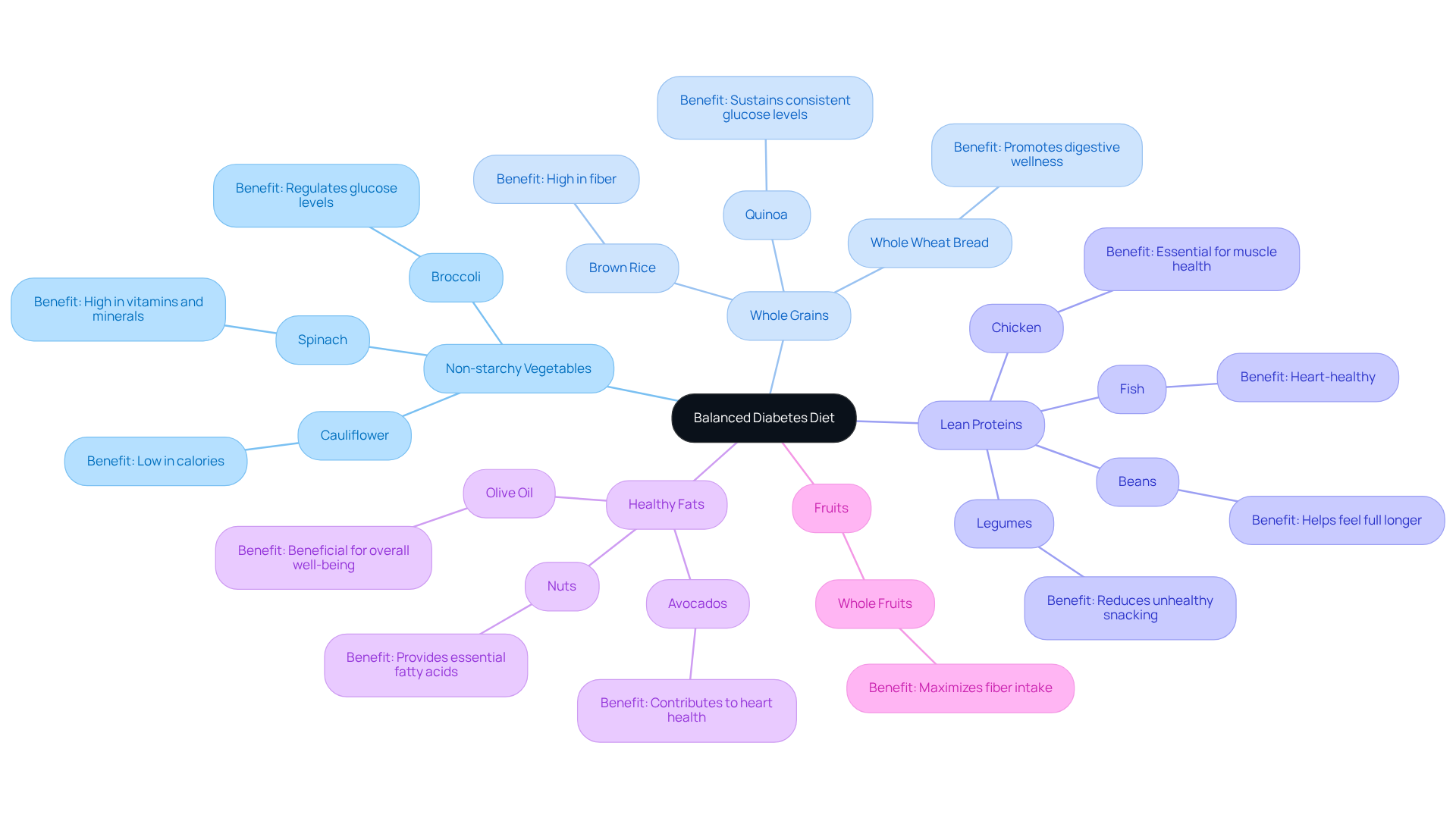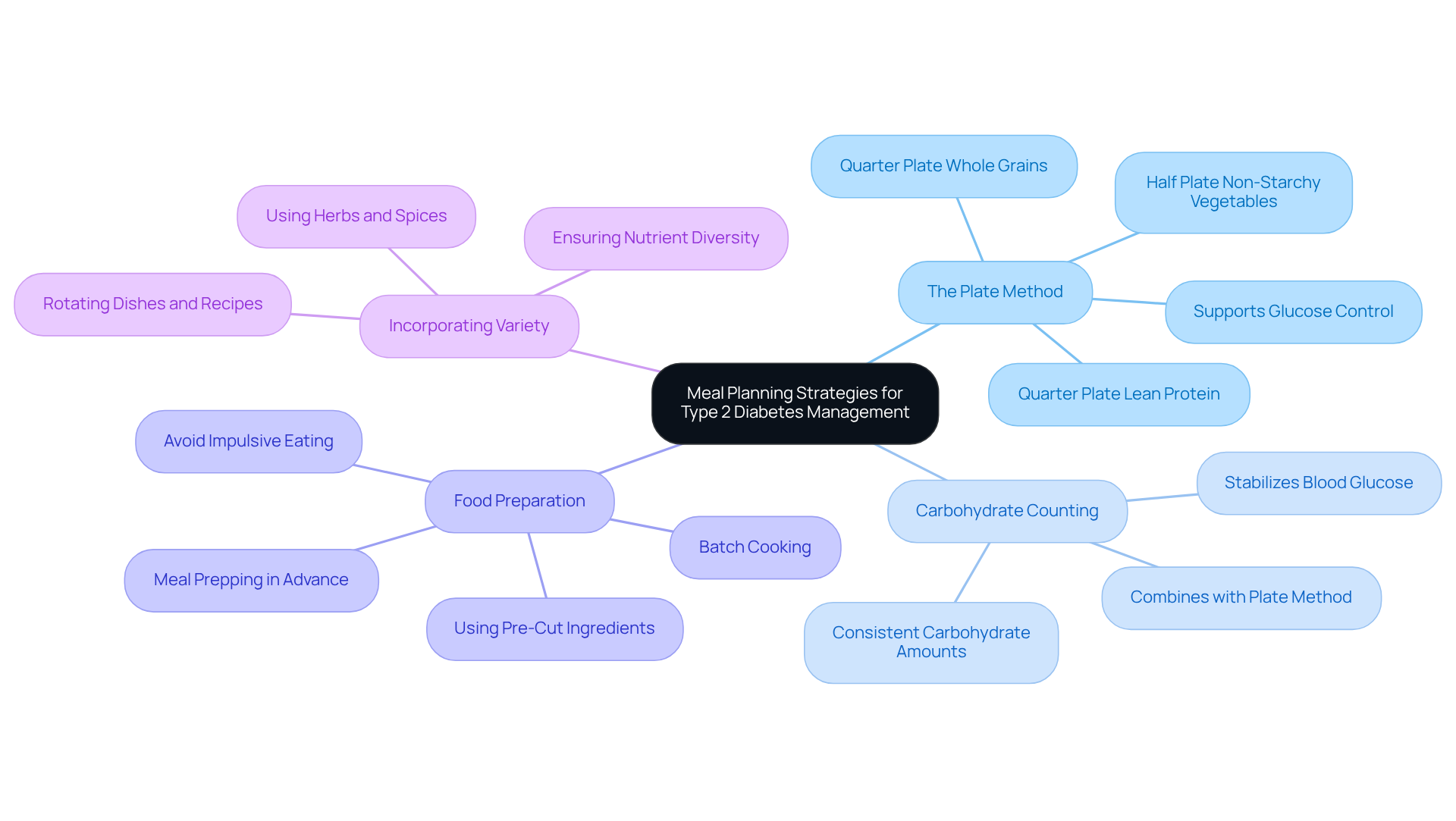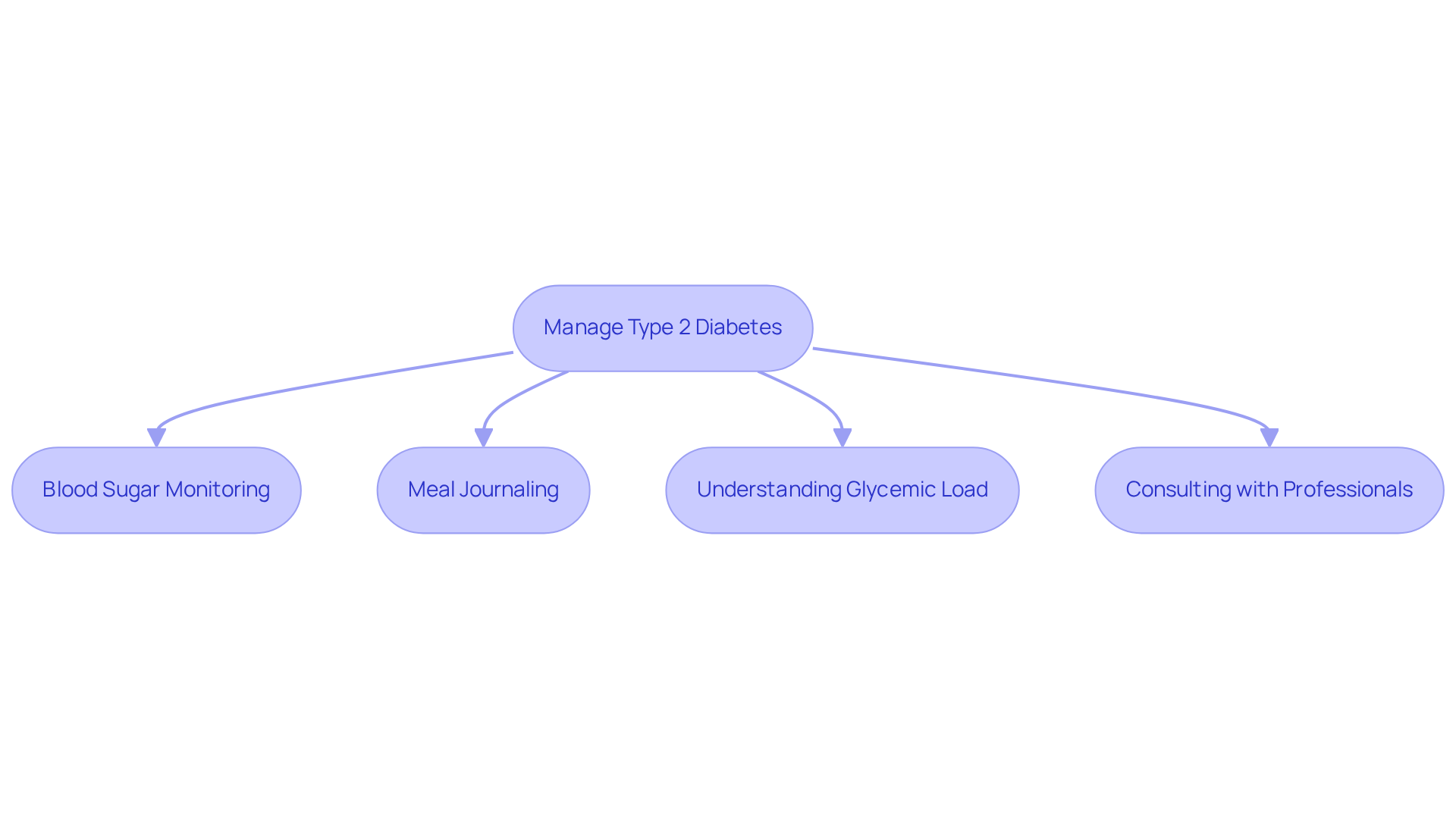Overview
If you have Type 2 Diabetes, it’s important to focus on nourishing your body with foods that are low on the glycemic index, rich in fiber, and encompass a variety of food groups. Think about incorporating:
- Non-starchy vegetables
- Whole grains
- Lean proteins
- Healthy fats
into your meals. These choices can help you manage your condition effectively.
It’s understandable to feel overwhelmed by dietary changes, but remember that balanced meals and portion control techniques, such as the Plate Method, can be your allies. Monitoring your blood sugar levels is also crucial; it informs your dietary choices and helps you maintain stable glucose levels. Together, these practices support your overall health.
You’re not alone in this journey. Many individuals are navigating similar paths, and seeking support or resources can make a significant difference. We are here to support you every step of the way.
Introduction
Understanding the dietary choices available for individuals with Type 2 Diabetes is crucial for maintaining stable blood sugar levels and promoting overall health. You're not alone in this journey, and it’s important to feel supported as you navigate your dietary options. This article delves into essential foods that can be incorporated into a diabetes-friendly diet, offering insights into how these choices can help manage your condition effectively.
However, with so much conflicting information about what constitutes a healthy diet for diabetes, it’s understandable to feel overwhelmed. How can you navigate these options to find a balanced approach that truly supports your health journey? We are here to support you every step of the way.
Understanding the Dietary Needs of Type 2 Diabetes
For individuals with Type 2 Diabetes, understanding what foods can I eat with type 2 diabetes is essential for regulating sugar levels and improving overall health. A balanced diet plays a fundamental role in controlling glucose levels and helps answer the question of what foods can I eat with type 2 diabetes, minimizing the risk of complications and aiding in weight management. When managing type 2 diabetes, it's important to consider what foods can I eat with type 2 diabetes, including the types of carbohydrates consumed, portion sizes, and meal timing. Understanding what foods can I eat with type 2 diabetes, particularly their glycemic index (GI) and how quickly they raise sugar levels, is crucial. When considering what foods can I eat with type 2 diabetes, foods with a low GI are typically preferred, as they lead to slower, more stable increases in glucose levels. For instance, incorporating whole grains, legumes, and non-starchy vegetables can significantly enhance glycemic control, helping to answer the question of what foods can I eat with type 2 diabetes.
Recent studies suggest that high-fiber items, such as beans and lentils, are among the options for what foods can I eat with type 2 diabetes, as they not only improve fullness but also assist in better glucose management. Nutritionists emphasize that a diverse intake of nutrients, including fiber, protein, and healthy fats, is vital for overall well-being, particularly in understanding what foods can I eat with type 2 diabetes. As one specialist observes, 'Managing glucose is essential to living well with diabetes, and understanding what foods can I eat with type 2 diabetes is crucial for regulating glucose.'
Additionally, T2DSolutions aims to support individuals on their diabetes management journey by providing educational resources and community support. Individuals with type 2 diabetes should consider what foods can I eat with type 2 diabetes and aim for at least 35g of dietary fiber per day to support their health. By focusing on these dietary principles and utilizing the resources available through T2DSolutions, you're not alone in navigating your diabetes management journey. We are here to support you every step of the way.

Essential Food Groups for a Balanced Diabetes Diet
A balanced diet for individuals with Type 2 Diabetes is essential, and it should include what foods can I eat with type 2 diabetes, focusing particularly on a variety of food groups and emphasizing non-starchy vegetables. These vegetables, such as broccoli, spinach, and cauliflower, are low in calories and high in essential vitamins and minerals. They truly form the cornerstone of diabetes management. Including a substantial amount of non-starchy vegetables in your meals can assist in regulating glucose levels and enhancing fullness without adding to weight gain.
Whole grains, including brown rice, quinoa, and whole wheat bread, are also vital. They are abundant in fiber, which helps sustain consistent glucose levels and promotes digestive wellness. Lean proteins, such as chicken, fish, beans, and legumes, are essential for muscle health and help you feel full longer, reducing the likelihood of unhealthy snacking.
It's important not to overlook healthy fats; sources like avocados, nuts, and olive oil contribute to heart health and provide essential fatty acids that are beneficial for your overall well-being. Fruits, while containing natural sweeteners, also provide fiber and nutrients that are essential for a balanced diet. Opting for whole fruits instead of juices maximizes fiber intake, which is crucial for blood sugar control.
By including these food groups in your everyday dishes, you can establish a satisfying and nutritious diet that answers the question of what foods can I eat with type 2 diabetes, aiding in effective diabetes management. For example, consider a sample dietary plan consisting of:
- A salad packed with mixed greens and vibrant vegetables
- A portion of quinoa
- Grilled chicken
- A side of fresh fruit
This approach not only enhances your health but also makes your dietary journey enjoyable and sustainable. Remember, you're not alone in this journey; we are here to support you every step of the way.

Meal Planning Strategies for Effective Diabetes Management
Meal planning serves as a powerful ally in managing Type 2 Diabetes, and it's understandable to seek effective strategies, such as identifying what foods can I eat with type 2 diabetes, that can make a difference in your journey. Here are some thoughtful approaches to consider:
-
The Plate Method: Imagine your plate divided into sections—half for non-starchy vegetables, a quarter for lean protein, and a quarter for whole grains. This method simplifies portion control and helps answer the question of what foods can I eat with type 2 diabetes while creating balanced meals. Research indicates that utilizing the Plate Method can support individuals in maintaining improved glucose levels by encouraging a balanced intake of nutrients, particularly for those asking what foods can I eat with type 2 diabetes. For example, a study revealed that participants who followed this method saw significant reductions in waist circumference and body fat percentage.
-
Carbohydrate Counting: Keeping an eye on what foods can I eat with type 2 diabetes can be pivotal in managing sugar levels. To manage your condition, aim for consistent carbohydrate amounts at each meal while considering what foods can I eat with type 2 diabetes. This practice is crucial for stabilizing blood glucose and can harmoniously blend with the Plate Method to help answer the question of what foods can I eat with type 2 diabetes.
Food preparation, like preparing meals in advance, can help you avoid impulsive eating and ensure that you always have healthy options at hand, particularly when considering what foods can I eat with type 2 diabetes. Batch cooking and portioning meals can save time and reduce stress, especially for those considering what foods can I eat with type 2 diabetes. For instance, roasting a large batch of non-starchy vegetables can simplify your week, making it easier to fill half your plate with veggies at every meal.
Incorporating variety in meals by rotating different dishes and recipes can help answer the question of what foods can I eat with type 2 diabetes while keeping meals exciting and ensuring a wide range of nutrients. Trying out various herbs and spices can enhance flavors without adding extra calories or sodium. This variety not only keeps culinary interests alive but also helps answer what foods can I eat with type 2 diabetes by providing diverse nutrients that support your overall well-being.
- Expert Insights: Diabetes educators highlight the significance of the Plate Method for portion control and recommend it when considering what foods can I eat with type 2 diabetes. One instructor noted, 'Creating well-rounded dishes that incorporate a range of groups can aid in regulating glucose levels.' This approach not only supports effective diabetes management by addressing what foods can I eat with type 2 diabetes, but also fosters a sense of community, enhancing your overall quality of life. Additionally, T2DSolutions serves as a valuable resource, offering insights and assistance for individuals navigating diabetes, including nutrition planning and guidance on what foods can I eat with type 2 diabetes.
Remember, you're not alone in this journey. We are here to support you every step of the way.

Monitoring Food Choices and Their Impact on Blood Sugar
Successfully managing Type 2 Diabetes involves understanding what foods can I eat with type 2 diabetes and their connection to glucose levels. Here are some essential strategies to consider that can empower you on this journey:
-
Blood Sugar Monitoring: Regularly checking your blood glucose levels before and after meals is crucial. This practice helps you understand what foods can I eat with type 2 diabetes and how they affect your glucose levels, allowing you to make informed dietary choices.
-
Meal Journaling: Keeping a meal diary can greatly assist you in tracking what you eat and how it relates to your blood sugar variations. This method enables you to recognize patterns and identify specific foods that may cause glucose spikes.
-
Understanding Glycemic Load: While the glycemic index is important, the glycemic load gives you a more comprehensive view by considering both the quality and quantity of carbohydrates in your meals. When considering what foods can I eat with type 2 diabetes, choosing those with a lower glycemic load can help minimize the impact on your blood sugar.
-
Consulting with Professionals: Working with a registered dietitian or diabetes educator can provide you with personalized advice and support, ensuring your dietary choices align with your health goals. Additionally, connecting with community resources and support groups can enhance your motivation and offer shared experiences in managing diabetes.
Incorporating these strategies can empower you to take control of your diabetes management, fostering a proactive approach to your health. Remember, you're not alone in this journey; we are here to support you every step of the way.

Conclusion
Understanding the dietary needs of individuals with Type 2 Diabetes is crucial for effective management of the condition. By focusing on the right foods, such as low glycemic index options, high-fiber items, and a balanced intake of essential nutrients, individuals can better regulate their blood sugar levels and improve their overall health. It’s important to recognize that a thoughtful approach to diet not only answers the question of what foods can be consumed but also lays the foundation for a healthier lifestyle.
Throughout this article, we’ve highlighted key strategies such as:
- Meal planning
- Portion control using the Plate Method
- Monitoring blood sugar levels
These are vital components of diabetes management. Incorporating a variety of food groups—including non-starchy vegetables, whole grains, lean proteins, and healthy fats—ensures a balanced diet that supports glucose control. Moreover, leveraging resources like T2DSolutions can offer valuable guidance and community support, making the journey of managing diabetes more manageable and less isolating.
Ultimately, embracing these dietary principles and strategies can empower you to take charge of your health. By prioritizing informed food choices and seeking guidance when needed, a fulfilling and sustainable approach to life with Type 2 Diabetes can be achieved. Taking the first step towards better dietary practices not only enhances your personal well-being but also fosters a proactive attitude towards managing diabetes effectively. Remember, you're not alone in this journey; we are here to support you every step of the way.
Frequently Asked Questions
Why is understanding dietary needs important for individuals with Type 2 Diabetes?
Understanding dietary needs is essential for regulating sugar levels, improving overall health, minimizing the risk of complications, and aiding in weight management.
What types of foods should individuals with Type 2 Diabetes consider?
Individuals should consider foods with a low glycemic index (GI), such as whole grains, legumes, and non-starchy vegetables, as these lead to slower, more stable increases in glucose levels.
How does fiber intake affect individuals with Type 2 Diabetes?
High-fiber items, such as beans and lentils, improve fullness and assist in better glucose management. It is recommended to aim for at least 35g of dietary fiber per day.
What role do carbohydrates play in managing Type 2 Diabetes?
It's important to consider the types of carbohydrates consumed, portion sizes, and meal timing to effectively manage glucose levels.
What nutritional components are vital for overall well-being in individuals with Type 2 Diabetes?
A diverse intake of nutrients, including fiber, protein, and healthy fats, is vital for overall well-being.
How can T2DSolutions assist individuals managing Type 2 Diabetes?
T2DSolutions provides educational resources and community support to help individuals navigate their diabetes management journey.



